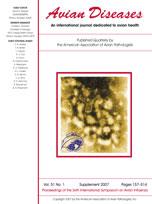Although fecal–oral transmission of avian influenza viruses (AIV) via contaminated water represents a recognized mechanism for transmission within wild waterfowl populations, little is known about viral persistence in this medium. In order to provide initial data on persistence of H5 and H7 AIVs in water, we evaluated eight wild-type low-pathogenicity H5 and H7 AIVs isolated from species representing the two major influenza reservoirs (Anseriformes and Charadriiformes). In addition, the persistence of two highly pathogenic avian influenza (HPAI) H5N1 viruses from Asia was examined to provide some insight into the potential for these viruses to be transmitted and maintained in the environments of wild bird populations. Viruses were tested at two temperatures (17 C and 28 C) and three salinity levels (0, 15, and 30 parts per thousand sea salt). The wild-type H5 and H7 AIV persistence data to date indicate the following: 1) that H5 and H7 AIVs can persist for extended periods of time in water, with a duration of infectivity comparable to AIVs of other subtypes; 2) that the persistence of H5 and H7 AIVs is inversely proportional to temperature and salinity of water; and 3) that a significant interaction exists between the effects of temperature and salinity on the persistence of AIV, with the effect of salinity more prominent at lower temperatures. Results from the two HPAI H5N1 viruses from Asia indicate that these viruses did not persist as long as the wild-type AIVs.
How to translate text using browser tools
1 March 2007
Persistence of H5 and H7 Avian Influenza Viruses in Water
Justin D. Brown,
David E. Swayne,
Robert J. Cooper,
Rachel E. Burns,
David E. Stallknecht
ACCESS THE FULL ARTICLE

Avian Diseases
Vol. 51 • No. s1
March 2007
Vol. 51 • No. s1
March 2007
avian influenza virus
environment
H5
H5N1
H7
high-pathogenicity avian influenza
persistence




